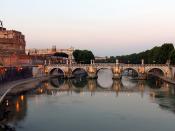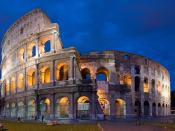Romans were collectors and admirers of Greek art. Art from Greece was brought to Rome, copied, and also changed by the Romans. As a result, Roman art is somewhat based on Greek art. However, Roman art is not merely a continuation of Greek art. For an amateur it is difficult to determine between the two art forms because neither the Romans nor the Greeks wrote down the history of their own art. The characteristics pertaining to each particular type of art are known to some extent, so the experts are relatively accurate in determining the separation of the two types of art. Roman art is divided into four categories: portrait sculptures, paintings and mosaics, relief sculptures, and statues. Each of these has its own characteristics. Portrait sculptures, designed by the Romans, shows the desire of the Romans for literalness; it records even the homeliest features. This is demonstrated in the sculpture, Head of A Roman, made of marble in 80 B.C.
The artist painstakingly reported each rise and fall and each bulge and fold of the entire facial surface. It was as if the artist was acting like a map maker, trying not to miss the slightest detail. The end product was a blunt, bald record of features. Idealism nor improvement of features was done causing the feeling of superrealism. Paintings and mosaics were influenced by the architecture of the Romans . Their architecture consisted of buildings containing a small number of doors and windows, thus leaving considerably large stretches of wall space suitable for decoration. The quality was determined by the importance and the wealth of the patron. The walls were used for two things in Roman art. First, they were used as a barrier. Secondly, they were used to visually open the wall and enhance...



Great work!
Hey!
You did a really great job on this essay! I just finished studying the Romans in History, and you covered pretty much all of the aspects of the Roman Civilization. Congratulations on a job well done!!
3 out of 3 people found this comment useful.